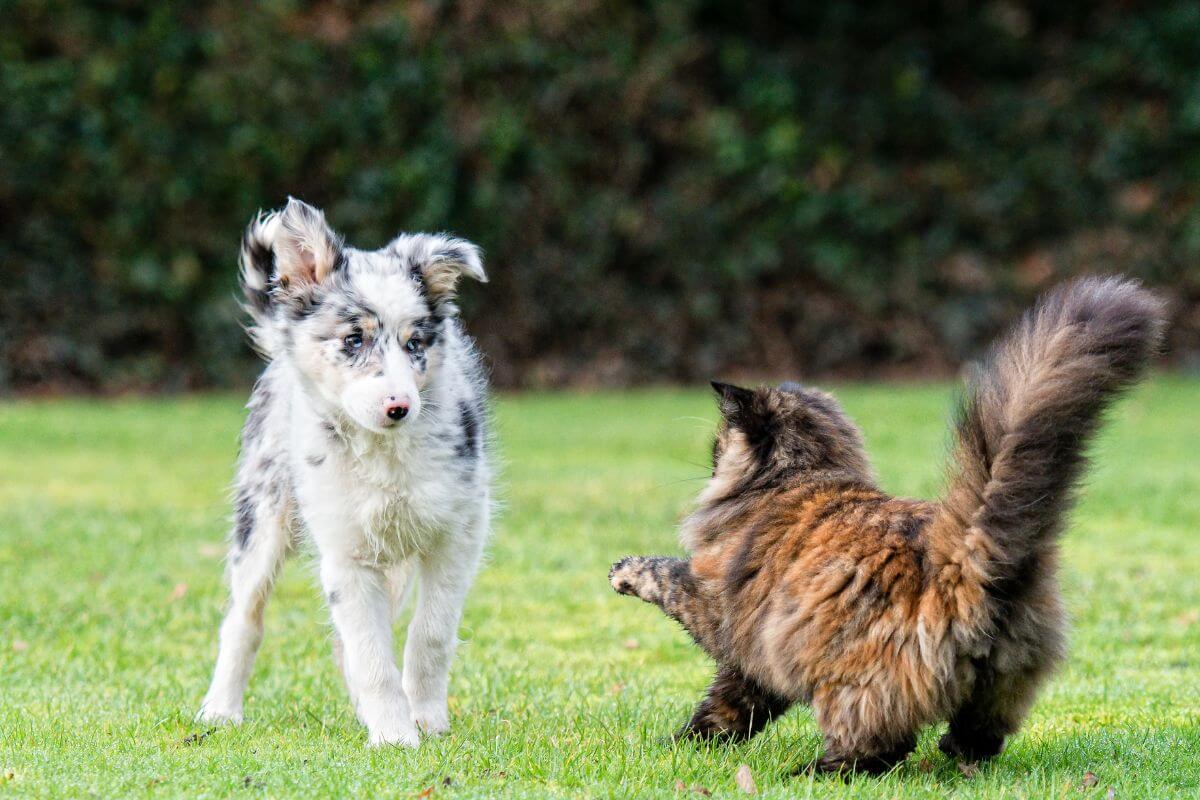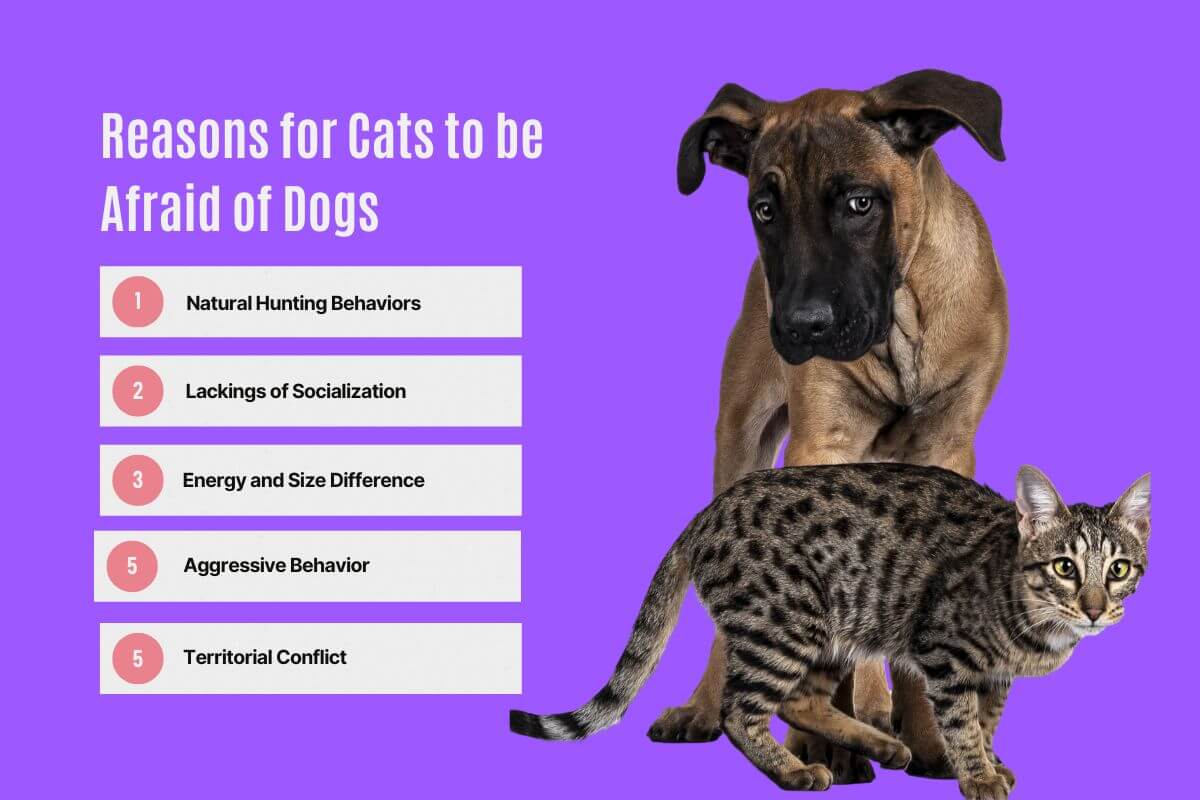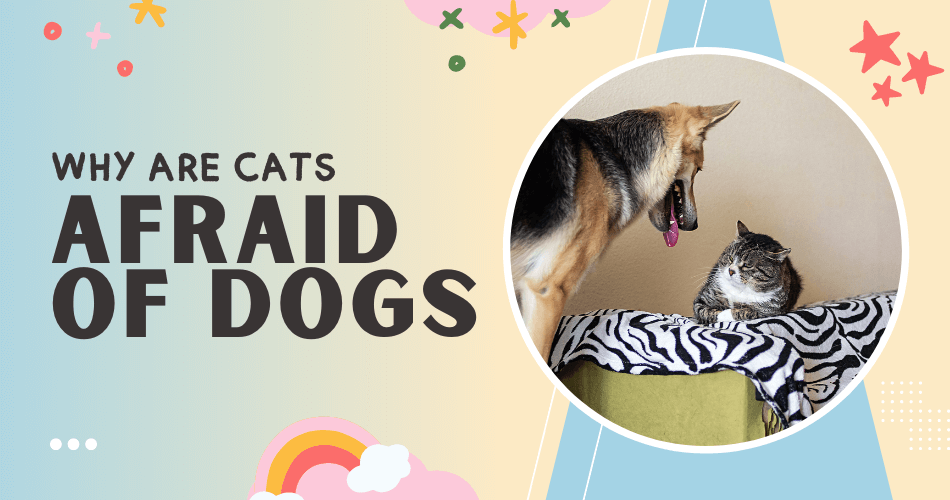You may have heard sayings like “fight like cats and dogs,” reflecting the natural tendency between these species. However, if we have seen anything on social media, we know they can coexist and even become friends.
It is common for your cat to show signs of fear, like hiding, hissing, arching their back, or fluffing their tails when introduced to your dog. But why do they act like that?
In this blog, we will observe the reasons so that you can make your dog and cat get along and even become friends. Let’s start.
What a Cat Feels When It Sees a Dog?

It is common for a cat to feel threatened when encountered with a dog. This often triggers a flight response, which can lead to aggression. The common ways your cat may show its discomforts are:
- Escaping or hiding from the scene
- Freezing in place, crouching, and pinning their ears back to appear smaller
- Fluffing up its tail to project anxiety
- Hissing to warn off potential threat
- Go in a defensive position like arching its back
- Biting or swatting to keep the danger away
So, when you see such responses, you should keep your cat away from the dog to keep it relaxed and playful.
Reasons for Cats to be Afraid of Dogs

There are numerous stories, legends, and myths about why cats fear dogs. Different cultures have different perspectives on this matter. However, scientifically speaking, the ultimate reason for cats to be afraid of dogs is a natural evolutionary instinct.
Let’s look at the 5 main reasons cats tend to avoid crossing paths with dogs.
Natural Hunting Behaviors
In general, cats are solitary hunters and are wary of beasts powerful and larger than them. On the other hand, dogs are expressive and high-spirited animals. This behavior of dogs is often translated as threats to cats.
Additionally, dogs have a tendency to chase smaller, fast-moving objects. This can be a fearsome experience for your cat. Therefore, it might keep its distance from dogs just to avoid any negative experiences.
Also, despite having positive experiences with dogs, cats always see and smell them as canines. So, if your dog is not properly introduced to the cat, they will always act cagey around the giant beast.
Lackings of Socialization
Pet cats are often raised in a household environment where dogs are usually perceived as pack animals. This varying social structure can cause massive conflict between these two furry pets.
Introducing a dog in a cat’s territory may threaten the later animal. Therefore, the smaller felines may act aggressively or fearfully.
Some kittens may have past bad experiences with dogs or may not even be exposed to other canines. Therefore, they will fear the presence of dogs and keep their distance to avoid fights.
Additionally, adult cats take more time socializing with dogs if they are not introduced at a young age. Three—to nine-week-old kittens are more open to new experiences, and it is high time to introduce them to other animals.
Energy and Size Difference
Cats tend to be much more timid than dogs. They often lie down here and there and spend their time leisurely. In contrast, dogs have higher energy and may run around the house. This can frequently scare the cat and make it fear the canine.
In addition, dogs are generally larger than cats. This can trigger insecurity and vulnerability in cats, which can cause stress and fear even if the dog is calm or lazy.
Aggressive Behavior
Cats and dogs have different communication styles, another reason cats fear dogs. Cats communicate with subtle body movement and vocalization. They may not move much except during their zoomies.
On the other hand, dogs are loud and much more physical when showing affection, which cats may see as an act of aggression. Thus, the Felis may not want to communicate with the canine and keep to itself.
Territorial Conflict
Both cats and dogs are territorial animals. Therefore, it is likely that a dog and a cat will fight to keep their territory.
However, being a bigger animal, a dog may have more advantages over a cat. This can keep the cat anxious and constantly on edge.
To avoid such incidents, you should intervene and keep your pets in separate spaces as a pet owner. Then, you can gradually introduce your pets to share the space. Also, make sure to separate your pets’ feeding bowls to avoid conflict among your furry friends.
Final Words
Both cats and dogs bring joy and happiness to our lives. However, when you are keeping both cats and dogs, they may see each other as enemies and competitors. Thus, knowing the reasons behind their hostility is crucial to avoid conflict effectively.
These are the 5 main reasons for your cat to fear dogs. So, you should be careful about these when adopting a new pet. You should introduce your furry friends with proper care and a loving attitude. This may start an unlikely friendship and instagram-worthy reals to melt a thousand hearts.

